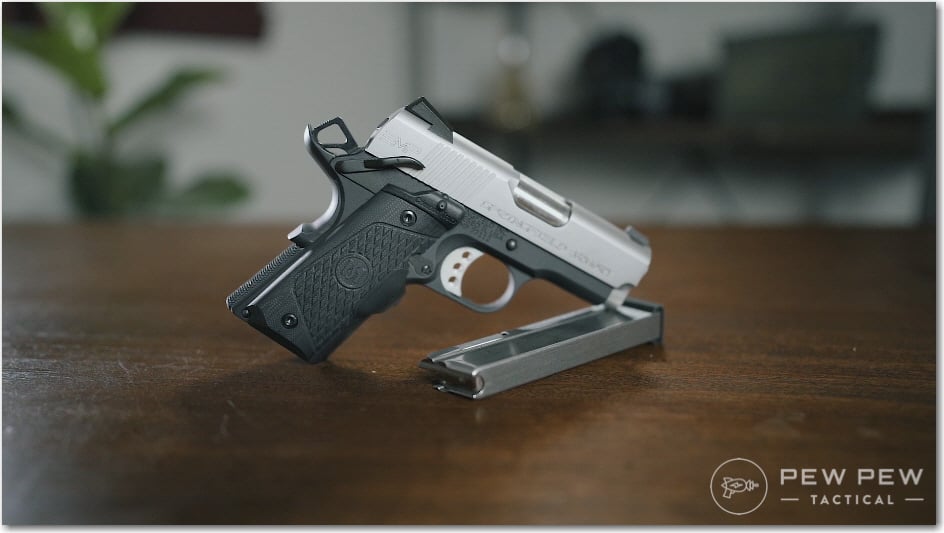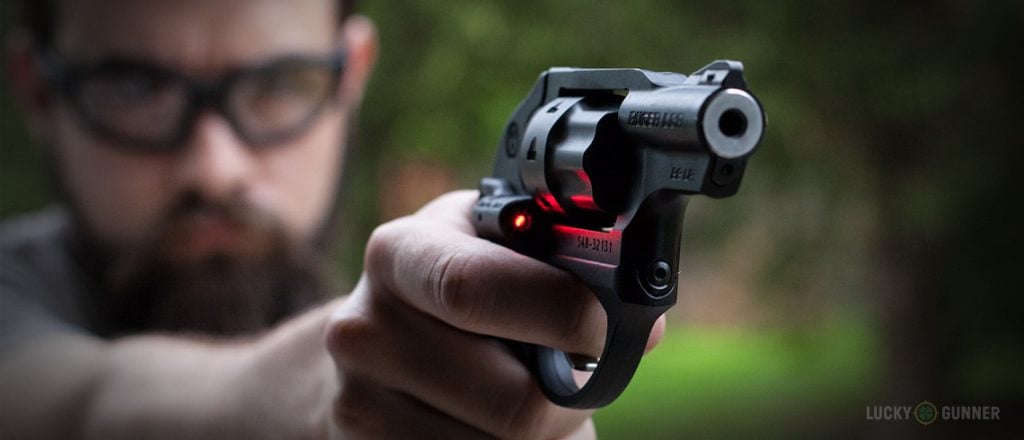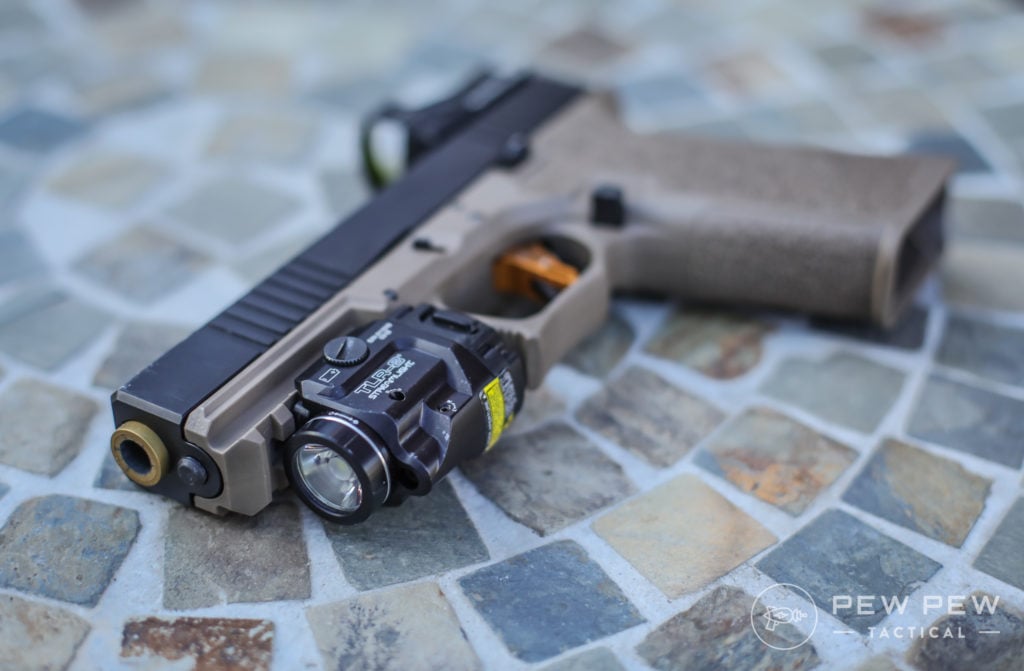Not too long ago the addition of lasers on firearms was considered a gimmick, but today that thinking has changed. Shooters are learning the value of laser sights, which allow you to shoot more accurately in low-light conditions and from difficult positions where you simply can’t raise and aim using traditional iron sights. This widespread acceptance of laser sighting systems has led companies to offer various options for shooters, and none is more basic than the option of selecting a red or a green laser.
But that choice is not as simple as it may initially seem. To understand how lasers work, we must first understand some basic physics. Light travels in waves, part of the electromagnetic spectrum. Different wavelengths in the visible spectrum produce different colors; red light waves range from 620 to 750 nanometers, and green light ranges from 495 to 570 nanometers. The human eye is better able to recognize colors in the green spectrum, so a green laser is more visible under bright light conditions. It would seem logical, then, that all firearm lasers would be green because they are the easiest to recognize in the broadest range of ambient light conditions. But there’s a catch—building a red laser is relatively simple, requiring only a diode, optics and some basic electronics to construct. Green lasers are more complex. Building a green laser requires a special 808 diode, a second infrared laser crystal and a frequency-doubling crystal, and these parts must be carefully aligned to produce the green laser image. For this reason, green lasers are more complicated, slightly larger and more time-consuming (and thus expensive) to build. When you are purchasing a laser for your firearm there’s an inherent tradeoff. If you want a smaller, lighter, cheaper laser, red is best. If you want a laser that is more visible under a wide variety of lighting conditions, you’ll need a green laser.
“Side-by-side, a green and red laser will result in a green laser that is easier to see during bright conditions,” says LaserLyte’s Dusty Gibson. “During low light conditions both are extremely effective. Right now green is about double the price of red with similar features. There is cheaper green, but you will sacrifice brightness or battery life.”
Gibson says that new technology is allowing companies to make smaller, less expensive green lasers, but that many customers are happy with a red laser that is more affordable and more compact. The choice between the two, then, is largely a matter of personal preference and budget, and the decision is ultimately up to the consumer. If your firearm budget is limited but you still want the convenience and added benefit of a laser, then a red model should work just fine under a wide variety of lighting conditions. If you have the money and want a laser that is highly visible even in bright sunlight, then a green laser is probably a better option. No matter which laser you choose, there are many advantages to adding a laser sight to your firearm. It’s a misconception that all dangerous encounters happen in dark conditions, and most shooters primarily practice on well-lit ranges where ambient light is sufficient to use iron sights. In low-light, however, the advantage of a laser becomes quite obvious, and under those conditions both a red and green laser will provide an advantage. There are more red laser options available today than green, but demand for green lasers has prompted companies to offer more options in this color. No matter which option you choose, the addition of a laser to your personal defense firearm makes sense because it allows you to shoot accurately even under the worst conditions.
Best Color Laser For Guns
Besides the obvious difference in colour, what exactly differentiates a red laser from a green one?
Green vs red lasers
Lasers are used in many trades – construction, installation, surveying. They project vertical or horizontal (or sometimes both) lines (green or red) for fast and effortless exact, accurate measurements over long distances. But what is the difference between red and green lasers? Ultimately, it comes down to the application and your budget. There is absolutely no difference in the accuracy provided, the key differentiators are price, brightness, visibility range, and battery life.
Red Lasers
Red lasers used to be all the rave. But ever since green lasers came along and technology evolved, they seem to have fallen to the bottom of the spectrum. Red lasers still provide exact accuracy, so of course the laser you choose depends on the application you will be using it for. They don’t produce as great a range as green lasers, though you can use a laser detector to improve and extend this. Benefits of owning a red laser is that they typically have a longer battery life than green lasers as they don’t require as much power and are cheaper almost all the time. They are also compatible with most receivers. This is because most receivers can only detect red light, meaning they wont work alongside green lasers.
“The human eye is far more sensitive to green than red. If you were to view a red and green laser of equal power side by side, the green laser would appear far brighter than the red one.”
Green Lasers
Green lasers are visible in a much wider range of lightings than red allowing you to be able to work both accurately and precisely even under the worst conditions. This is extremely handy for work all year round, indoors and out, rain or shine. Did you know that a green laser light is ten to 50 times brighter than a red light laser? Green lasers are much more efficient and visible in areas of broad daylight and direct sunlight. They are also able to travel longer distances, which is why they are so popular on construction sites.
Bear in mind, though that green lasers are typically higher in cost than red. This is because they have more components and better laser diodes than red. But fear not, here at Toolstop we offer finance to help split the cost! Just because they are more visible and have a better range, doesn’t always mean that they are better. It comes down to the individual and the application. Again, they have the exact same accuracy!
Green lasers are 4 times more visible to the human eye than red lasers of the same output power
Should you go for a green laser or red laser?
Though green lasers have a longer range than red, you can often purchase a red laser AND a laser detector for the same price, if not cheaper than a green one which will often allow you to achieve the same range.
Essentially, as is expected, it comes down to visibility. Green lasers, like the DCE089D1G are brighter and therefore have better visibility, especially when they’re used outdoors. And because of that, they’re a bit more expensive.
Red lasers, like the DCE089NR are still great, though, particularly if you use them with a detector, in which case you’ll significantly increase the range and the visibility.
Which is the best laser level?
Below we have put together a table with some of our bestselling and must have lasers available to shop at Toolstop. Take a look at their main features and benefits.
- Dewalt DCE089D1G Green Laser
- Bosch GLL 3-50 Red Laser
- Dewalt DW088K Red Laser
- Ridgid CL-100 Red Micro Laser
Dewalt DCE089D1G 10.8V Self Levelling Multi Line Green Laser
Features:
- Projects bright horizontal and vertical lines
- Full-time pulse mode allows use with a detector, maintaining full brightness for optimum visibility
- 30m working range (50m with detector)
- This self-levelling multi-line laser is accurate to ±0.3 mm/m in all levelling applications
- IP65 rating and drop tested to 2 meters
Specification:
- Accuracy: +/-3mm@10m
- Battery Voltage: 10.8
- Battery Capacity: 2.0 Ah
Most Powerful Green Laser Gun Sight
Crimson Trace Lasergrips Series
If you’re looking for a laser sight that is easy to use and won’t make concealed carry a hassle, then Lasergrips by Crimson Trace ($200-$500) might be perfect for you.

Unlike most laser sights that mount under the barrel, the Lasergrips sight mounts to the rear of your grip and projects the beam from the base of the slide.
One of the coolest things about the Lasergrips sight is that you don’t have to worry about fumbling with pressure switches in strange places to activate the laser.
All you need to do is hold the grip of your gun naturally, and the beam switches on automatically.

The Lasergrips sight is designed to fit snugly onto your grip, where it is pinned into place. Because of how it mounts to the gun, there’s no way that a one-size-fits-all model would work.
Fortunately, Crimson Trace has made 85 models, each compatible with a specific type of handgun.
Along with some of the most common handguns like 1911s and Glocks, there are also a number of different revolver models that support Lasergrips as well.
2. Streamlight TLR-8
If beefing up home defense is your top priority, then the Streamlight TLR-8 is right for you. It can deliver pinpoint accuracy in tactical situations without completely shattering your budget.

There’s a common misconception that laser sights help you see better in the dark.
While they certainly make it easier to aim in low-light situations, if you can’t make out your target with iron signs, a laser sight isn’t going to make it any brighter. And this is precisely why you’d want the TLR-8 for home defense.
What makes this laser sight special is its ability to give the shooter the best of both worlds.
You get a LED white light that kicks out 500 lumens as well as a coaxial red or green laser. And you have the choice of switching between the white light and the laser, or you can use them together in the same situation.
With the TLR-8, you’re able to not only improve your aiming and target acquisition, but you can also use the white light to distinguish between friend and foe.
The sight comes with a key kit that makes it compatible with a variety of different handguns, and it also fits on the Picatinny rail as well.
